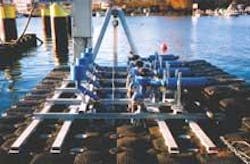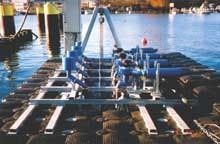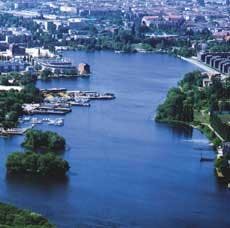Submersible blowers aerate Berlin waters
By Chris Davis
Submersible blowers rejuvenating the Rummelsburger See in the heart of Berlin operate at noise levels well within accepted environmental limits, with higher efficiency than typical land-based blowers. A technical innovation developed by Adams Ricardo of Bristol, UK, the blower is submerged in water to dramatically reduce the noise level. Cooler underwater temperatures increase air density, which enable the blowers to run more efficiently.
Since 1989, one of the city's most radical environmental projects was to re-establish a nature reserve around parts of the Rummels-burger See, a three-km2 lake, in addition to rebuilding the residential area. Luxury apartments have been built and more are under construction around the once thriving harbourside.
The Rummelsburger See was stagnant, and the Berlin Senate knew they had to solve this major problem to attract residents to the area. Years of use as a harbour and the lack of oxygenated water flowing through it resulted in a lake empty of any wildlife and discoloured due to the huge amounts of algae that had formed. The government contracted the German company AGO HydroAir GmbH to solve this problem but knew that the answer would not be straightforward.
The solution was to aerate the water; however, a typical land-based blower solution capable of aerating the entire Rummelsburger See would have caused major noise pollution not only for the residents living in the area, but also for the planned nature and wildlife park. Tests conducted by Adams Ricardo and HydroAir showed that land-based blowers would operate with a noise level of 86 dB(A), a level far above what is acceptable for a residential area. A jumbo jet taking off creates 80 dB(A) at a distance of 300 metres. The cost of silencing the blowers would be astronomical since the permissible noise above the background level was almost zero. The background noise level drops at night, the very time when people are most aware of noise, and any noise would have been propagated with minimal loss across the surface of the water.
HydroAir specified the Adams Ricardo submersible blowers. Each blower, made of cast iron and coated with epoxy paint, is supported in a galvanised steel cradle suspended from a floating pontoon moored in the middle of the lake. This approach saves construction and land acquisition costs since it eliminates the need to erect a building to house the blowers. Furthermore, it minimises the visual impact due to the low profile of the equipment and its distance from the shore. The blowers are each capable of blowing 456 m3/hour free air delivered (inlet air at 15°C at sea level) against an operating pressure of 630 millibar. The air then passes via a common manifold down two separate coarse air bubble diffusion pipes of 0.9 km and 1.3 km respectively which go in different directions from the pontoon to give overall coverage of the lake. The main contractor T.O.P.P. Anlagenleasing GmbH secured these pipes to the bed of the lake.
AGO Hydroair tested the noise of the blowers from the shore at 4 a.m. on a still morning at a distance of 200 metres and recorded a level of below 41 dB(A) - well within acceptable environmental limits.
Following completion of successful trials by Adams Ricardo, the blowers were installed in March 2002 and found to be more efficient than had been anticipated for a land based equivalent. Both T.O.P.P. and HydroAir decided that operating just two blowers at a time was adequate as the backpressure was less than originally expected, so they rotated the use evenly between all four blowers. Operating experience elsewhere has shown that lubricant can last three years for a blower operating continuously. Blowers operating on an intermittent duty should only require service every five years.
The submersible blowers are expected to save the Berlin Senate approximately 15% in energy costs. The extension of service intervals should produce significant further savings.
Author's NoteChris Davis is the managing director of Adams Ricardo, based in Bristol, England.


